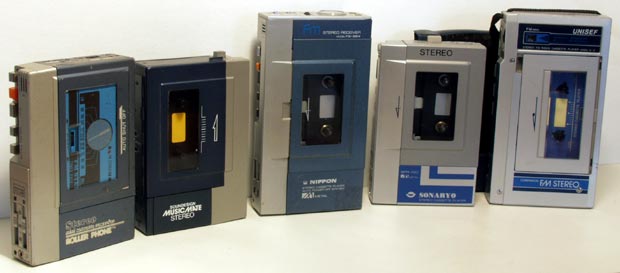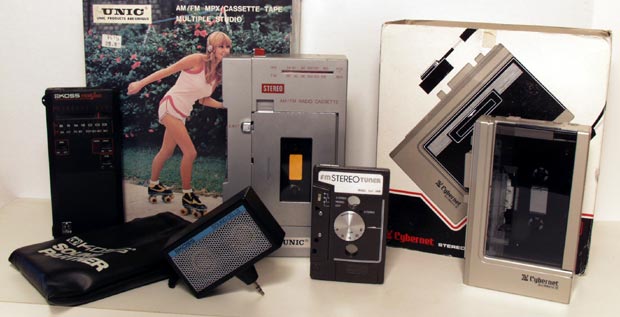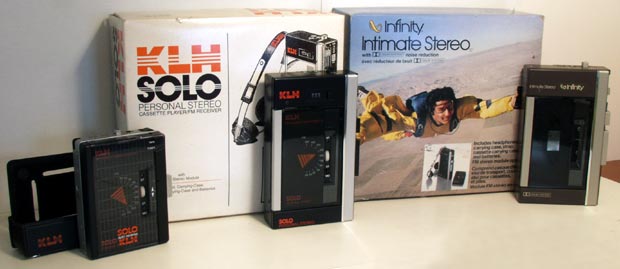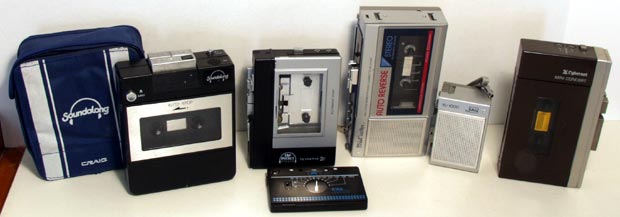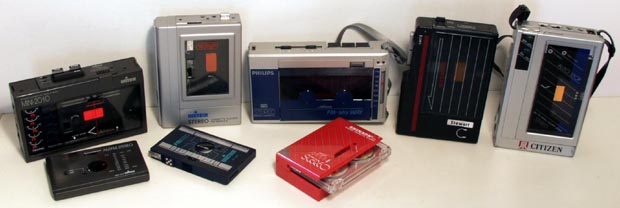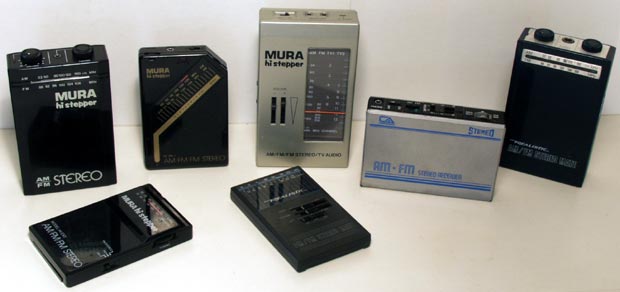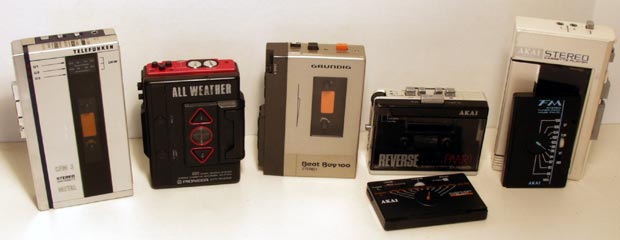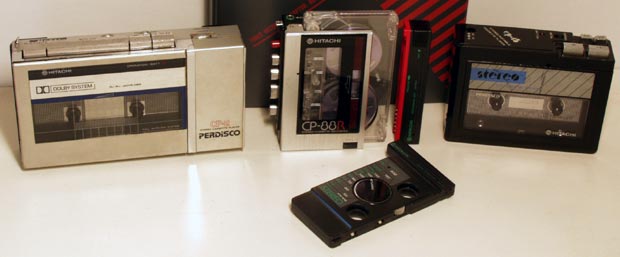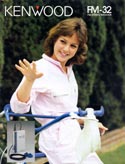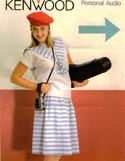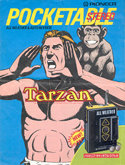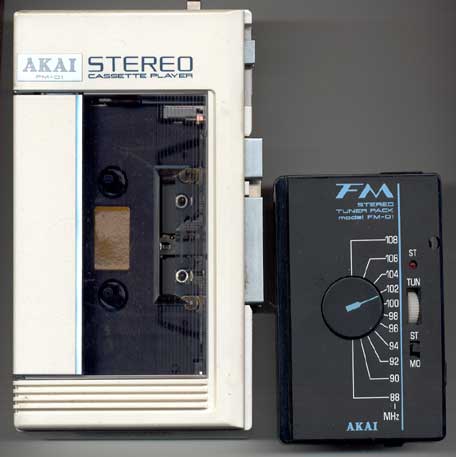
Akai PM-01
1981. Akai was a leader in consumer audio and video electronics throughout the ’80s, and their PM-01 was a reflection of their product quality. This portable stereo was one of the earliest portable stereos, sold in 1981 for around $175. The chassis is refined pearl white color with silver trim, protected in a blue vinyl case. The buttons are large and solid; the metal volume slide controls have the perfect tension. This stereo, like many of the day was equipped with dual headphone jacks and a “talk” button that activated an amplified microphone, allowing the user sing along with the music, or listen to ambient noise during his personal music experience. Akai also equipped the PM-01 with an FM tuner module shape (FM-01) like an audio cassette. Load the stereo with this piece and listen to FM radio, as well..
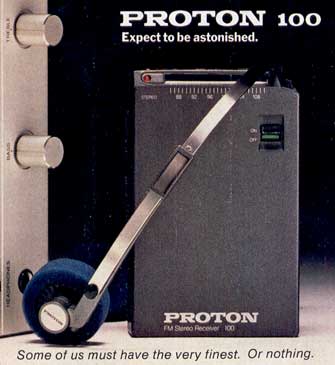
Proton 100 FM Stereo Receiver
1982. Top-notch audio and video component company decides to hop on the portable stereo bandwagon and charge twice the average price. Needless to say, Proton didn’t last very long in the walkman market. This the only release we could find, the 100 FM Stereo Receiver. It was a portable that boasted sound rivaling audiophile-grade home equipment, equipped with Proton headphones and a very simple design.
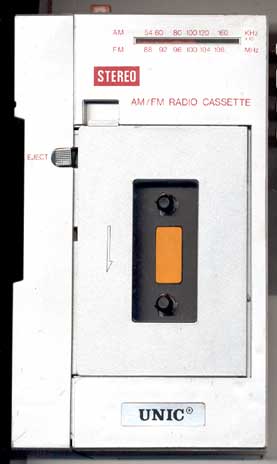
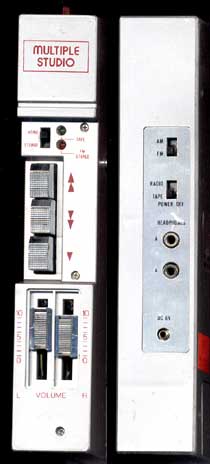
Unic Multiple Studio RV-2
1981. One of the earliest affordable portable stereos to hit the streets complete with cassette and AM/FM tuning was this one, by Unic. Called the “Multiple Studio” this giant portable had a bevy of features: LED indicators, eject button, dual headphone jacks and DC power capability. This is the largest personal stereo I’ve ever seen–it weighs over a pound without batteries and it’s twice the size of the Sony WM-F100. The manual boasts a “4-track 2-channel stereo” and circuitry including 4 ICs, 11 transistors, 12 diodes and 2 LEDs.
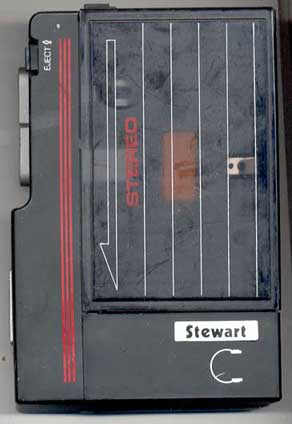
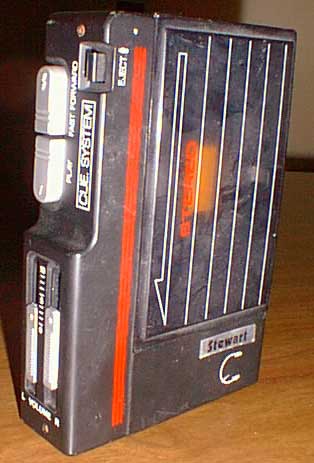
Stewart ST977
1982. Stewart’s ST977 stereo cassette player is just of glimpse of the junk from China and Hong Kong that inundated a world captivated by Sony’s TPS-L12 Walkman. Since the average person in 1981 couldn’t afford to drop over $100 on a portable radio, models like this one from Stewart were well-received. This one featured separate left and right volume controls and an eject button–two luxury features found on only the priciest portables of later years. In the early days however, nearly all Walkmans and portable cassette players had these features. Also note the controls (Stewart called it a Cue System): play, fast forward and stop. Where’s the rewind? Well, to make a portable affordable, you gotta cut corners somewhere, right? Here’s another pic.
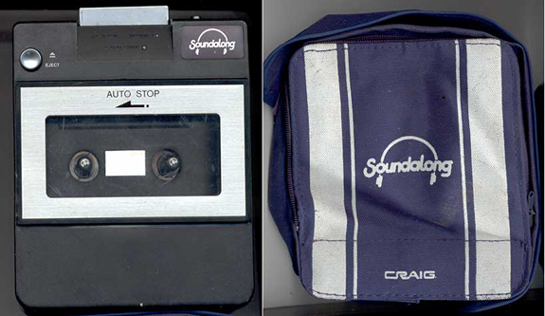
Craig Soundalong J700
1981. The first discount walkman was Craig’s Soundalong, priced at around $100 back in ’81. It featured most of Sony’s TPS-L2, but lacked the performance and size. The Soundalong offered a “hotline” style microphone, twin headphone jacks, and left and right volume controls. This was a bulky portable stereo, but it fit nicely in its snazzy little nylon and velcro carrying case. I hate to admit it, but this is one of my favorites.
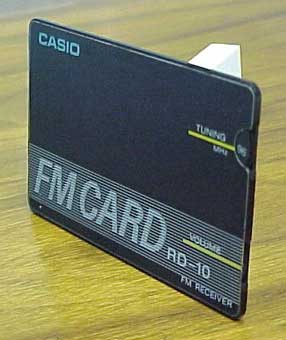
Casio RD-10
1985. Casio made brief entrance into the portable stereo market back in 1985 with the RD-10–the thinnest FM stereo to date. Our friend Oscar discovered this in an Orange, CA pharmacy way back when and hasn’t let go if it since–in fact, he grabbed a second! He paid $13 for it–now that was money well spent! Don’t let go of this one, it was Casio’s first effort at a micro-portable stereo, a magical gadget indeed. Thanks Oscar!
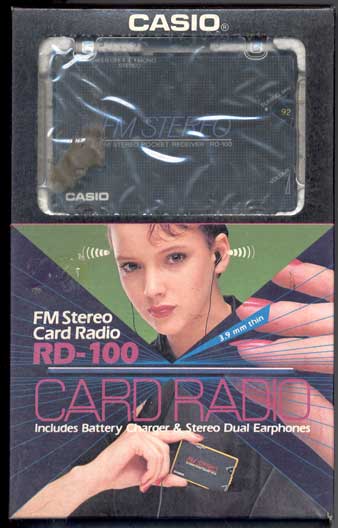
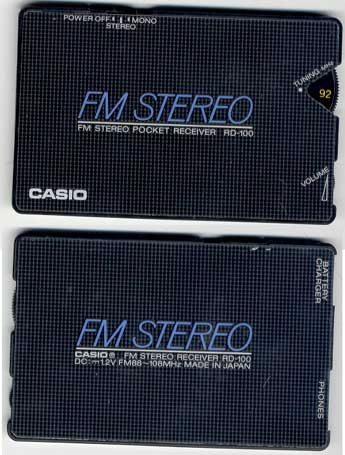
Casio RD-100
1986. Following the RD-10, Casio released the RD-100, another credit-card size FM stereo. The RD-100 had a combination power/mono stereo switch, and an AC charger and bud headphones–both plugged into the card using a unique ultra-thin jack. This particular model was very short-lived and like many of Casio’s products, available only for a few months.
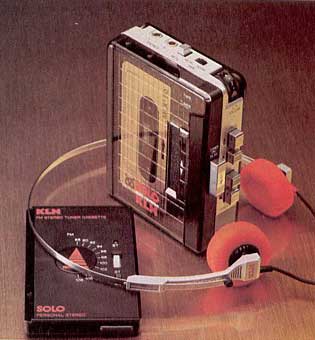
KLH Solo
1982. Japanese electronics company Kyocera was an early force in the portable game with their Solo. The Solo initially hit the scene in late 1980. Pictured above is a high-tech looking 1982 model featuring an unusual clear plastic well-door, left & right volume controls, twin headphone jacks, auto-reverse, an FM/FM stereo cassette module for radio reception and according to its buyers, good performance. DAK was a chief distributor for the initial Solo and the subsequent release in 1982. The one pictured initially sold for over $150, but by late 1983 had dropped to $70.
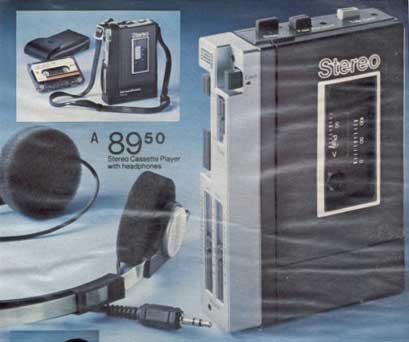
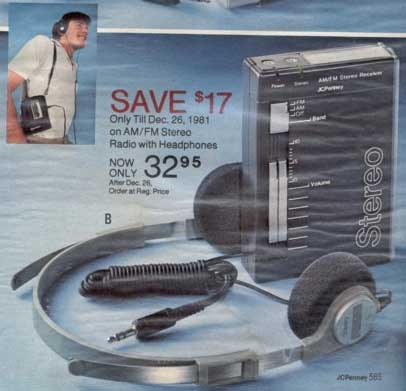
JC Penney SurroundSound
1981. US department store and catalog distributor JC Penney would not be left in the cold amidst the profitable “walkman craze” so they released their SurroundSound portable line. No relation to the everyday stereo effect we enjoy today–could JC Penney have coined this phrase nearly 20 years before? Interesting… Like Sears, JC Penney usually resold a another company’s product with their brand name slapped on it. Wonder who made the SurroundSound? Both the radio and cassette player look nice and seem to feature left-right volume controls, twin headphone jacks and carrying case. The player sold for just under $100, the radio was around $30. Check the picture of the a AM/FM stereo–don’t you wish you were the guy in the corner picture?

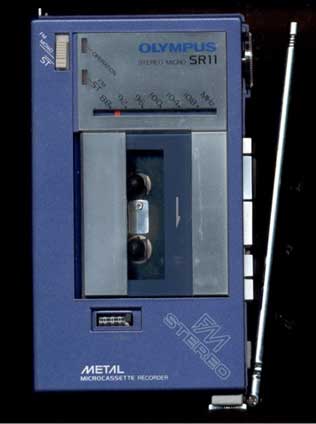
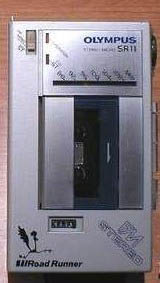
Olympus SR11
1982. We’re all familiar with the Olympus cameras, but their Pearlcorder micro-cassette recorder line was well-respected among businessmen in the ’70s and ’80s. Sometime in the early ’80s, Olympus crossed over into the portable stereo line with the SR11. A very tough unit to find today, the SR11 was feature-packed–it recorded in stereo onto micro-cassette from microphone or separate audio device (via its line-in jacks), had an FM tuner, tape counter, tape speed option, stereo/mono setting and battery LED indicator. Very well-made portable despite the child-like road-runner cartoon in the corner. A nice selection of colors: offered in gray, blue, black and red. Here’s a picture of the box.
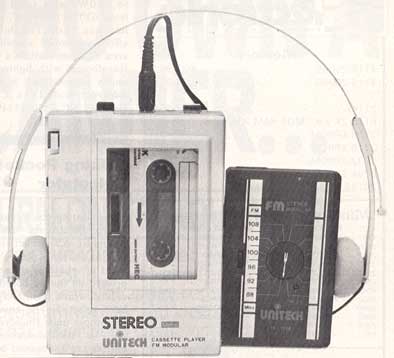
Unitech Pocket Concert Plus
1982. We discovered an ad for this one while perusing an old Popular Electronics one afternoon. Distributed by DAK, a popular ’80s catalog sales company, the $69.50 Pocket Concert Plus was made to “satisfy angry customers everywhere.” Apparently the original Concert Plus sold out, and DAK promised customers something better. The average person looks at this and probably sees a piece of junk. And, well, they’re right. This ain’t no Sony or Aiwa, but it does have one nice feature–the FM tuner module. This tiny radio is shaped like a cassette and slides into the player, allowing the listener to tune in the FM band. Stations were selected using a little dial on the top. This was very cool concept in portable stereo technology at the time that was also being done by Toshiba, Sanyo and Sharp. Obviously, DAK was jumping on the portable bandwagon with the Pocket Concert Plus. We wonder if this was their own imaginary name for the unit–do you see “Pocket Concert Plus” mentioned anywhere on the player?
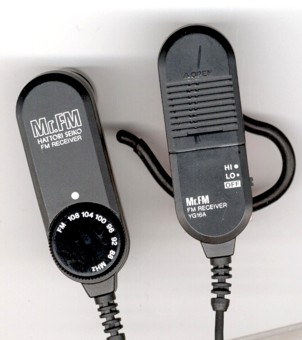
Hattori Seiko Mr. FM
198?. Seiko’s Mr. FM is probably one of the small FM radios ever sold. Its design was simple and appealing–it consisted of two pieces that hooked to the ear with rubber hooks. They were connected by a single insulated wire, and that was it, no cassette-sized receiver, no belt clip, nothing. One side had a battery compartment and off-hi-lo switch for controlling power and volume, the other had a tuning knob; both powered sound to the ears. Mr. FM was elegant and simple, but some reason the concept never took off. To our knowledge, this was Seiko’s only endeavor into the portable stereo market.
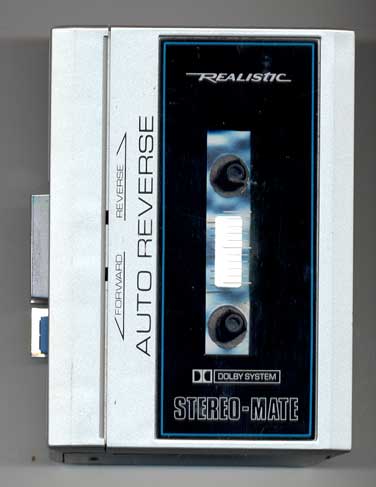
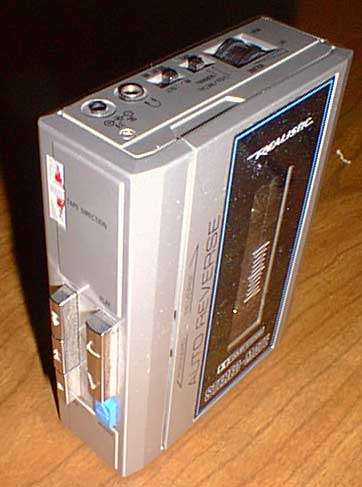
Realistic Stereo-Mate RCP-19
1985. Radio Shack was probably one of the top US distributors of portable stereos in the ’80s–their cost and convenience made something like this Stereo-Mate RCP-19 available to anyone. This particular model was feature-packed and small, too. It offered left-right volume controls, normal/metal tape selector, Dolby noise reduction and auto-reverse! Take a look at this picture and check out the cool LED indicator for tape direction. Slap a pair of high-end Nova’s on this baby and you’ve got some wicked sound!
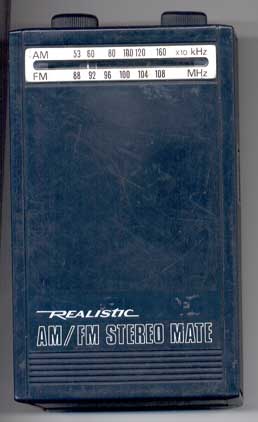
Realistic Stereo-Mate 12-111
1982. Very sturdy AM/FM portable stereo by Realistic. Tuning knobs prominently placed on top so one could tune as they were jogging or cycling. Very small left-right balance dial in the back (where it should be–how often does one really use this feature?) This is the only walkman we know of that used a 3/4″ headphone jack.
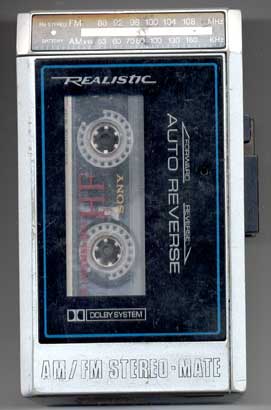
Realistic Stereo-Mate SCP-5
1984. Don’t be deceived by the photo–the tuner display is actually positioned at a slant–the scanner makes it look like it’s been living underwater for the past decade.. This portable featured AM and FM tuning, auto-reverse, separate left-right volume control, a Dolby NR switch (labelled “out” and “in” for some reason) and a normal/metal tape switch. Feature-packed for the period, of course.
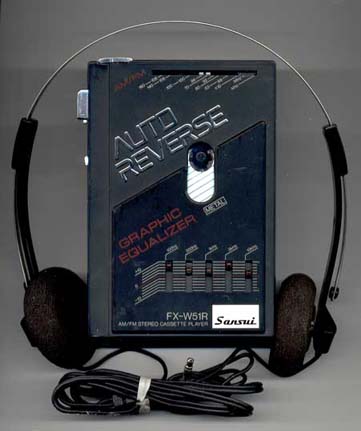
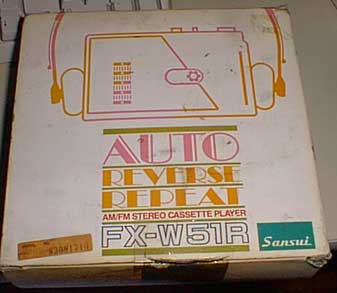
Sansui FX-W51R
1986. Nice package–sleek black chassis with chrome highlights, feels durable. AM/FM tuner, equalizer and auto-reverse and auto-repeat features are nice, controls place smartly on the side. LEDS to indicate tape position are nice, too. But where’s the friggin’ rewind? Sadly, no matter how much you play with the equalizer, the cassette audio still sounds crappy. Maybe I got hold of a lemon, but the wow feels like it about 10% on this. No wonder why Sansui dropped out of the walkman market.
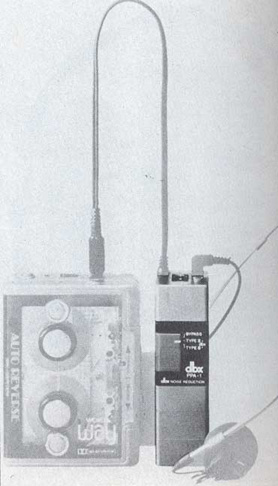
dbx PPA-1 Silencer
1983. Wow, I’ve got to get my hands on one of these. It’s not a portable stereo, it’s an add-on marketed for portable stereo cassette owners way back as a solution for noise reduction! dbx was an early competitor to Dolby in the early days and the portable was a hot market for NR. This incredible little gadget was fitted between the cassette player and headphones. The NR circuitry kicked in with the flip of the switch allowig only hiss-free sound to reach the ears. Though it wasn’t advertised anywhere on the unit, another flip of the switch allowed the user to enable Dolby B noise reduction. Sadly, the PPA-1 never caught on.
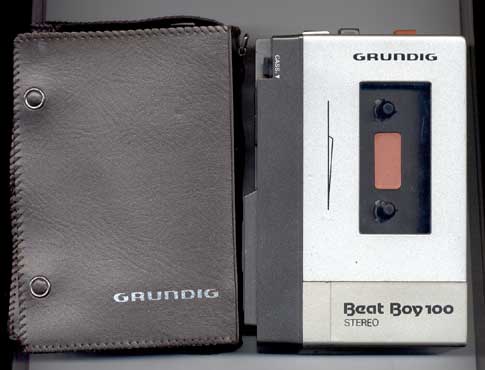
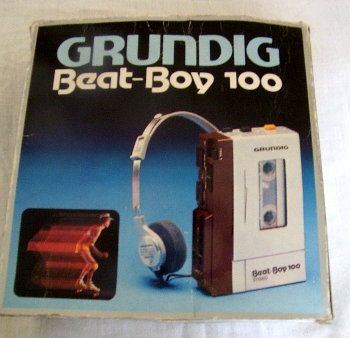
Grundig Beat-Boy 100
1981. News to us, Grundig made a TPS-L2-like portable stereo, called the Beat-Boy. One can see Grundig desperately trying to emulate the innovator by coming up with its own witty, cute name for a portablet, though the German manufacturer is well-known in the US for its shortwave receivers, and their brand name commands respect among SWL-ers. In Europe, Grundig is known as an all-around consumer electronics manufacturer, and their quality is, or at least was in the 70s and 80s. The Beatboy appears to have all the features of other portables in that time period. The disco-roller skater on the box is a nice touch, too.

Nippon (NEC) FS-884
1982. Another “boat anchor” from the dawn of portable stereos, Nippon’s FS-884 closely resembled the TPS-L2 in looks, right down to the gray-blue color. This was obviously an effort to “one-up” Sony by including an FM tuner. Paul’s a fan of these huge beasts–he didn’t think twice about pulling this one from an electronics shop in Manhattan recently.
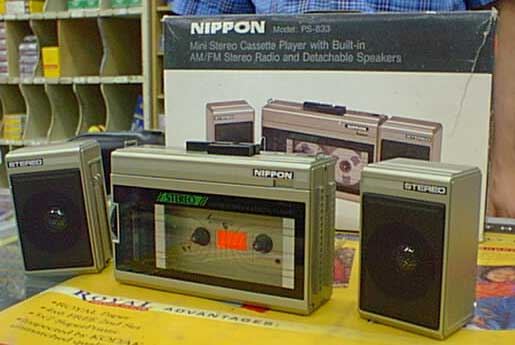
Nippon PS-883
198?. This oddity was spotted at a camera shop of all places, lurking behind a giant ghetto blaster of the same brand name. Yes, those are stereo speakers which detach from each side of the walkman. No matter how much I negotiated, I couldn’t talk the salesman down from his asking price of $80 (slashed from the 1980s price of $160, a real bargain!).
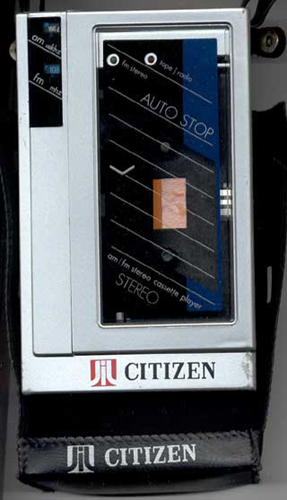
JIL Citizen JWS556-S
1984. We’re at a loss to figure out what the name of this thing is. Those of you familiar with wristwatches can see the Citizen name on the bottom of the unit. However, the manufacturer mentioned in the manual is Jutan International Limited, or JIL. We’re guessing the intent of this no-name brand was to dupe buyers into thinking they’re were getting a brand-name walkman. This company distributed several varieties of portables to Canada under the names Citizen, Candle and Walkymusic. It’s pretty confusing. At any rate, the performance of this model is on par with other discount brands, though the features for the time are fair: left-right volume slide controls, twin headphone jacks, AM & FM tuning and LED indicators for each, normal and metal tape switch. Ugh, another clunker with no rewind button. Gotta flip the tape and fast forward if you want to get back to the beginning of the tape.
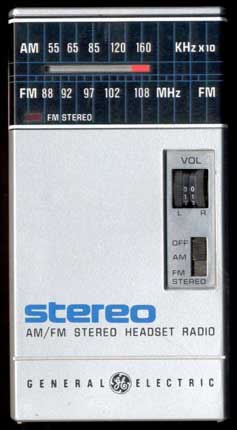
GE 7-1600
1983. Nice little unit offered by General Electric with plenty of functionality in a small package. The 71600 offers AM-FM-FM Stereo listening and the separate volume levers for left and right channels are a nice touch. Sold in Service Merchandise for $25.
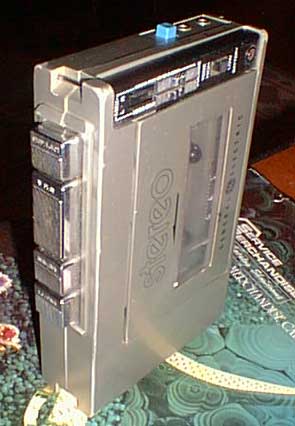
GE 7-5270
1981. GE’s response to the Walkman was the Escape line offered in local department stores at reasonable prices. The Stereo Tape Escape, a cassette player was offered initially, was then followed by the Stereo Radio Escape, an portable FM stereo and the Great Escape featured both an radio tuner and cassette player. The Stereo Tape Cassette was offered initially and featured separate left and right volume levers, two headphone jacks, a hi-lo tone switch and a mute button. Not quite a “Hot Line” button, this simply cut the sound to the headphones when pressed.
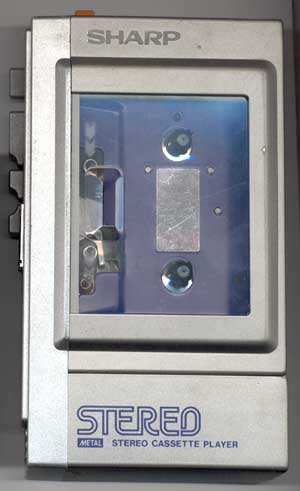
Sharp WF-50G
1981. Sharp perpetuated radio “tuner pack” trend in personal stereos with this model. The WF-50G is remarkably similar to the initial Toshibas right down to the color scheme of the pleather carrying case. The Sharp feels solid, probably due to the metal chassis but has a simple mute button rather than the cooler talk button. Check out the close-up of the removable FM tuner pack!
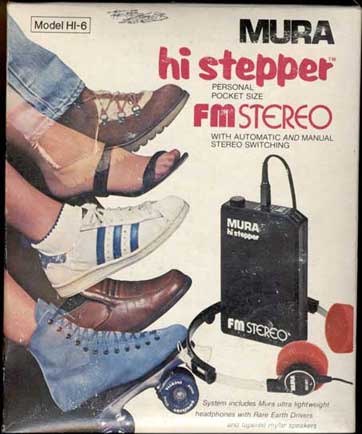
Mura Hi-Stepper HI-6
1982. For all of us whose weekly allowances just couldn’t handle the purchase of an SRF-30W, thank goodness we could turn to Mura. The Japanese electronics company was known for their affordable telephone and microphones, so entering the portable stereo and headphones market seemed logical. The Hi-Stepper line was a big hit in discount and department stores. Jay and I remember vividly the portable stereo shelves at K-Mart being filled with boxes like this one. This was a nice little stereo–reception was good, both the receiver and headphones were well-made, too. If you find one of these on your travels today, chances are it’ll work fine!
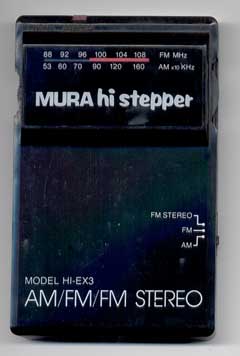
Mura Hi-Stepper HI-EX3
1985. The HI-EX line started in 1982 and was Mura’s flagship portable stereo, combining functionality and good sound in a slim package. The initial model offered hi-lo tone switch and FM stereo reception. This particular model offered AM/FM and FM stereo reception. Both dropped the notion of an on/off switch–when the bud earphones were plugged into the jack, the radio powered up.
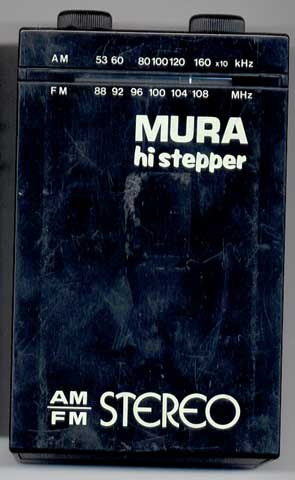
Mura Hi-Stepper HI-3
1982. Mura’s initial portable stereo. Very successful, mainly because it provided AM and FM stereo sound at an affordable price. A recessed balance knob was located on the back and easy access volume and tuning knobs were mounted on the top. Yes, they took Sony’s “Mystereo” look and feel and implemented into their own product, but who could blame them. The design was a good one. Those who wanted to go even cheaper could grab the FM-only HI-6.
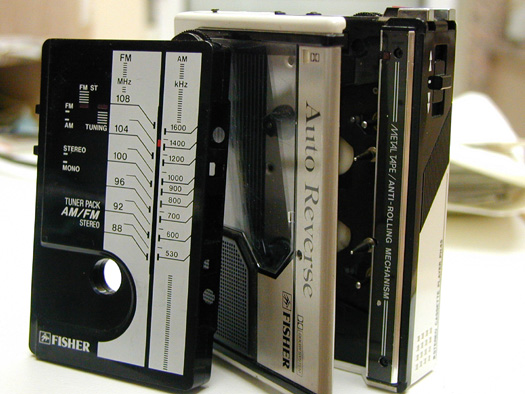
Fisher PH-45
198?. Fisher is well-known in the home audio arena, but did you they also manufactured portables? Probably not, if you live in the US, as they were far more popular in Europe. This PH-45 is a slim stereo cassette that offered AM and FM tuning through the separate tuner pack module. The anti-rolling mechanism indicates this one was probably sold around 1986. This was also brought to our attention by Vassilios from Greece. Thanks again, Vassilios!
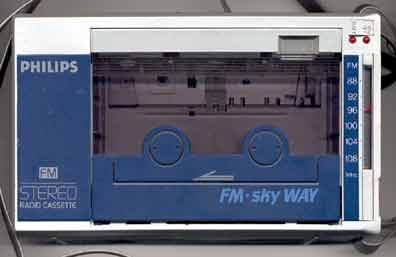
Philips Sky Way D6628
1982. This clunky plastic thing has charm but is nonetheless one of the more cost-conscious models of the day. The FM stereo cassette Sky Way was awkward, but did come with a shoulder strap. There are FM stereo and battery LED indicators, a balance and volume slide controls. Recessed cassette controls include a stop/eject button, play and rewind. The Sky Way had no fast-forward control. We believe Magnavox marketed the same models in the US under the Sky Master line.
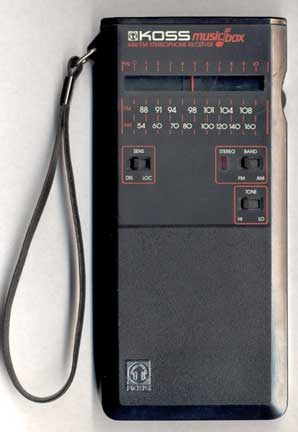
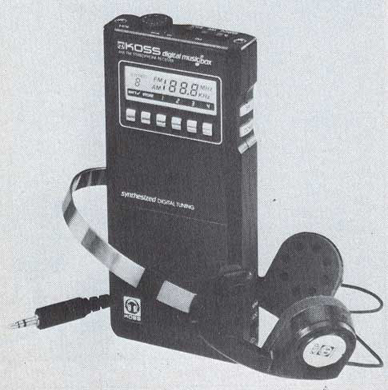
Koss Musicbox
1981. Handy little “stereophone” receiver from headphone giant Koss that offered some unique functions–local/DX switch, stereo LED, hi/lo tone setting and an LED indicator that displayed when more than 95dB was travelling to the headphones. We assume this was to serve as a warning the user of a health risk. The wrist strap looks a little annoying. These were common on the portable transistor radios from the previous decade, but were pretty much phased out as the Walkman boom hit. In 1983, Koss enhanced the MusicBox by going digital. We believe this is the first walkman to feature digital tuning.
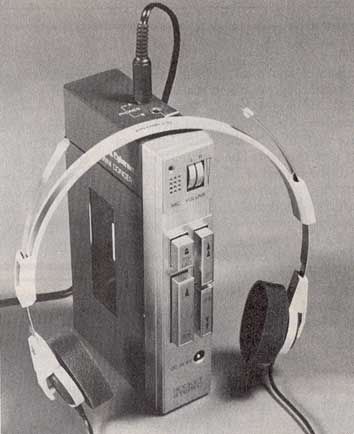
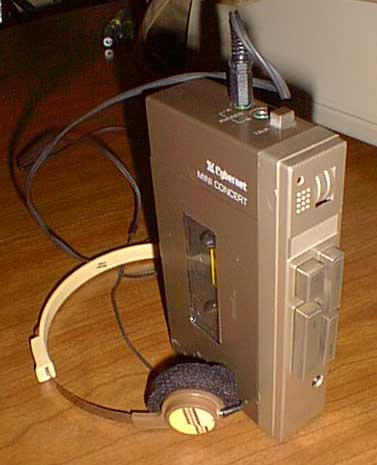
Cybernet Mini Concert PS-01
1981. This portable reached the masses through one of the many ad blitzes by DAK in the early ’80s. DAK called this the “Pocket Concert Hall” but it was actually Cybernet’s Mini Concert, a wannabe Sony TPS-L2 with all the looks and functionality of the real mccoy, but with a nice price–$69. DAK claims in their ad that over 100,000 of these had been manufactured using Sony-grade hi quality, but the product couldn’t compete with the plummetting prices of the Walkman and cheap knockoffs from Hong Kong. So, Cybernet “logically” opts to sell their remaining 35,000 units for nearly half the wholesale price. We’re not sure what the result of this marketing campaign was, but this baby is pretty rare these days.
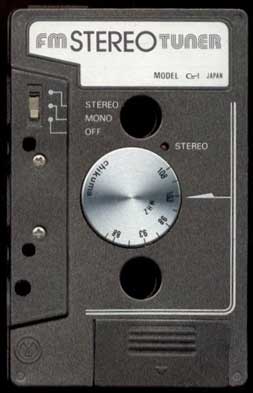
Chikuma C-1 FM Tuner Cassette Module
1981. Back in the early days of portable stereos, cassette players with AM or FM tuners were a rarity. A cheap and effective way of bringing radio listening to your cassette-only Walkman was to purchase one of these. This cassette-shaped FM receiver was inserted into the player–when the user “played” the module, he was able to listen to the radio! The device worked much like a current day CD player-to-cassette player adapter in that the magnetic signal was sent into the tape head and converted to audio. Very cool idea, and portables with this feature are among our favorites.
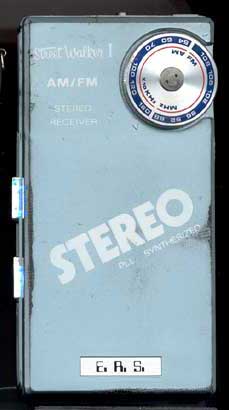
E.R.S. Street Walker I
1981. Another example of the Walkman copycat epidemic was this sad little plastic radio, called the Street Walker. Powered by three penlight batteries, this “PLL Synthesized” stereo receiver tuned AM and FM and had an onboard microphone for its talk feature.
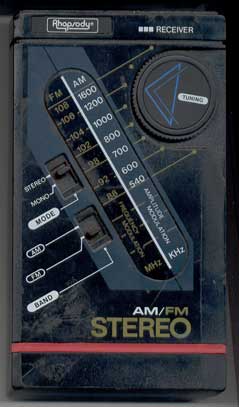
Rhapsody AM/FM Stereo
198?. This little portable stereo is actually pretty well made. The color scheme is a little tacky, but it has a stereo/mono switch, left and right volume control knobs and a stereo LED indicator. It’s nice that they actually spelled out amplitude modulation and frequency modulation on the tuner readout, just in case you forget.
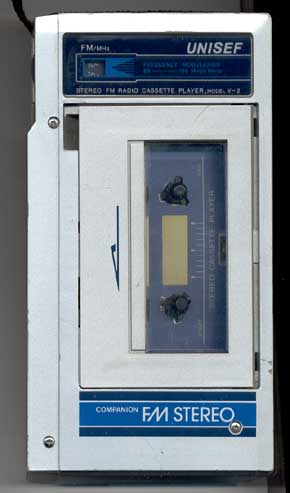
Unisef V-2
1982. Unisef is one of those no-name brand johnny-come-latelys that was eager to produce affordable personal stereos like this one, the V-2. It lacks a rewind button and a volume slide control that imitates one with separate left and right channels control. Surprisingly enough, this model is made in Japan but nonetheless has a cheap feel to it. It has a stereo/mono switch and an FM tuner. That blue tape location indicator in the window is a cheap paper sticker that’s about to peel off.

Windsor CS-880
1982. Another cheapie from our friends in Hong Kong, the CS-880 offered AM and FM tuning, green and red LED band indicator, stereo/mono switch, left right balanace knob and twin headphone jacks. Its protective sheath was a sleak, sexy black vinyl.
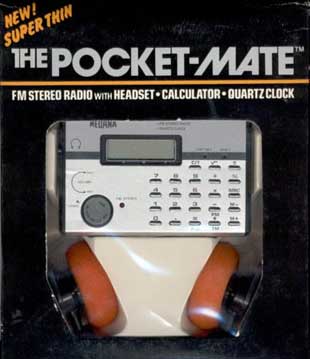
Medana Pocket-Mate
198?. Medana could easily be written off as yet another Hong Kong knock-off manufacturer, but somehow, perhaps accidentally, creativity reared its head in some of their products. The Pocket-Mate is one example. You’ve got your calculators and you’ve got your walkmans, but why not roll the two together? Come to think of it, why not add a clock too? Medana did just that, and came up with a snazzy little product. At first glance, you might anticipate the tuning being digital and using the calculator’s LCD display, but no such luck. Only a drab FM radio and run-of-the-mill calculator, but the Pocket-Mate was probably priced at around $20-30, making it a real bargain.





